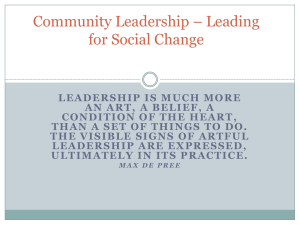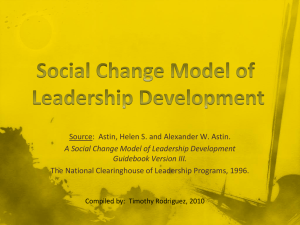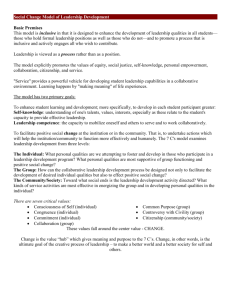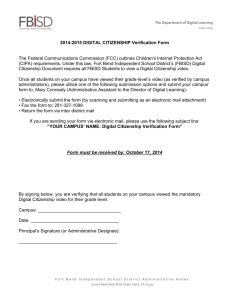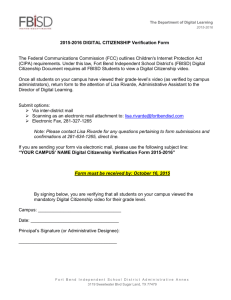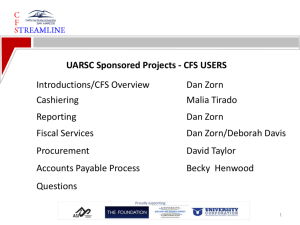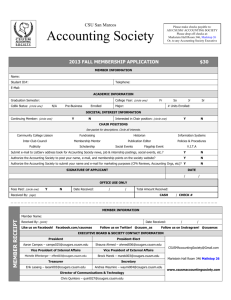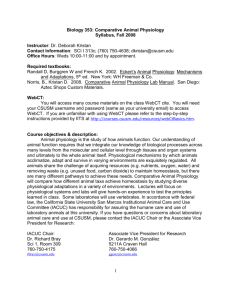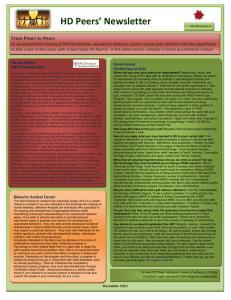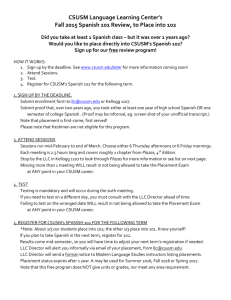CSUSM Leadership - California State University San Marcos
advertisement
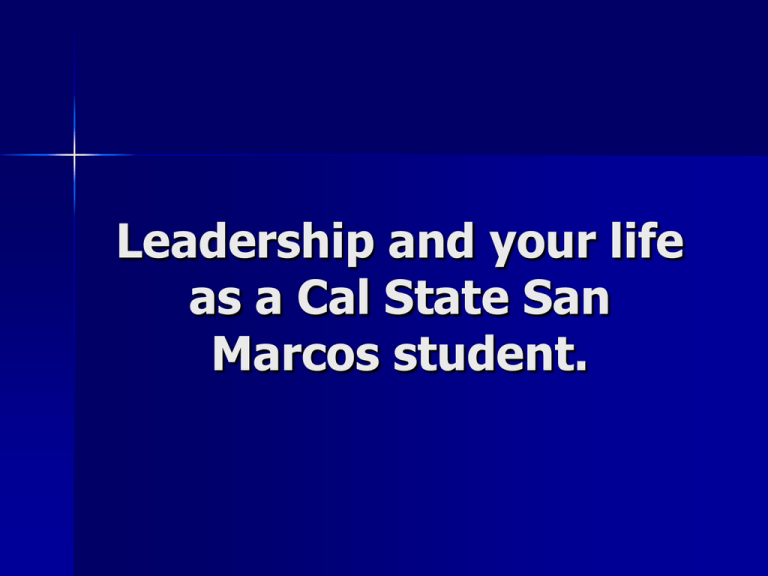
Leadership and your life as a Cal State San Marcos student. Leadership in your life The first few weeks and months of your first year can prove to be both challenging and exciting because of the many opportunities that are available to you Through multiple experience you will begin to learn more about yourself and what you can and cannot handle as you begin this new chapter of your life. Some question that may have come to your mind during transition period include: What I am doing here?, who am I?, How do I make this decision? And Where do I begin? If you have tried to answer to any of these questions, you are not alone. College provides an environment and the opportunity where you become a leader in your own life and the knowledge and skills to the entire campus community and beyond. I’m a Leader? Leadership is define as lifting of people’s vision to a higher sight, the raising of their performance to a higher standard, the building of their personality beyond its normal limitations. In order to become a leader in your life, the first step is to reflect on who you are and what you believe. In addition, leadership involves taking accountability for who you are and what you believe. What do you value? How often do you get asked who are you? To many people, specially college students, this is one of the most difficult questions to answer and, many times, the answer changes frequently. In order to explore these question, it is important to reflect on what you value: Do you value education? Family? Health? Once you are able to identify your core values, you are then able to start to make informed decisions and create a clear path for your life. If you don’t know what you are doing and why, it becomes that much harder to complete a task or achieve your goal. If you know what you stand for and hold important to your life, you can be confident to express your thoughts and feelings to others around you Being able to identify your values is difficult but a crucial step in becoming a leader in your own life. What are your top five values? How are your values reflected in your everyday life? Take responsibility Once you begin to reflect on your values, you will have a better sense of what is important to you and what you are willing to stand up and take responsibility for. One of the most important characteristic of a leader is the ability to take personal responsibility and ownership over their life. One of the vast difference between high school and college is the power you have over your education. This means that you have a power to choose the class you take and if you will attend class on any given day. Due to this your role in your education journey is huge. This is time to feel empowered and start chanting, “No one can do it for me” So what does taking responsibility look like? Utilize resources available to you at campus Take ownership over your schedule and use an organizational system. Remember the planner you received at orientation? Use it! Ask Questions so you know what is expected of you. In order to take responsibility for your education, you need to know what is expected. Ask questions, meet with your professor and utilize your classmates. If you don’t understand it is your responsibility to clear up the confusion. Remember that you are adult now. Yes it can be scary. Repeat it to yourself a few times. Part of being adult is taking responsibility for your actions, beliefs, thoughts, and behavior. College is the safe environment to learn how to be an adult but the most important factor in this development is you. Like everywhere else there are rules and regulations you must follow and they are in place for the good of the whole campus community Be informed and understand what the university is holding you to. What does leadership look like at CSUSM? Leadership in high school and leadership in college may be expressed very differently. In high school you might think of leadership as related to popularity or position in student government. On the CSUSM campus, leadership is more regularly reflected in responsibility, initiative, preparation and contribution an individual makes to group projects in classroom. Social change model of leadership The social change model of leader ship was developed at University of California, Los Angeles, and specifically provides to one major dilemmas configuring any modern democratic society: how to reconcile the twin values of individualism and community. College is important time to discover the individual that you are in the context of an academic and social community filled with challenge and support. The social change model of leader ship defines values of leadership across three spheres: the individual, the group, and the community/society. It acknowledges that all students have the potential to be leaders. That leadership is a values-based process, and that by nature, leadership is collaborative and often rooted in the vehicle of service to others. Within each of these three spheres of influence are values called the seven C’s of leadership. Individual values include consciences of self, congruence, and commitment. Group values include collaboration, common purpose, and controversy with civility. Community values include citizenship and change, with change as the ultimate outcome of the expression of leadership. Collaboration Common purpose Controversy with civility Group Values Congruence Commitment Consciousness of Self Individual Values Citizenship Social/Community Values Consciousness of self Often, college is the time that students find themselves figuring out who they want to be. It takes work and time to figure out who you are. Depending on your personal background, you may be further along on this journey than your peers, bout the journey of self-discovery is life long and cyclical. Sometimes lessons repeat throughout your life. The value of learning and specially life long learning is embraced at CSUSM. This is why you are currently taking GEL which is stands for life long learning education. One activity that may assist you in identifying activities or leadership opportunities that match you natural talent is identifying your leadership orientation. What is your leadership orientation? Take the leadership online survey that can be find at http://www.leebolman.com/self_rating.htm The letter with the highest total corresponds to your strongest leadership orientation. A corresponds to analytical leadership B corresponds to human resource frame C indicates political leadership D symbolic leadership If you are analytical leader, your personal style is grounded in facts, research, homework, preparation, and planning. You tend to focus on data , structure, plans and policies. If you are a human resource orientation leader you focus more on relationships and listening. You may find yourself drawn to teamwork, communication plan, and opportunities to empower others A political orientation has little to do with politics, but instead reflects the heart of an advocate and negotiator. You may find it easy to navigate informal and formal network, develop and agenda and built allies to achieve your goals. Symbolic leaders set the vision of what to come. They can communicate a deep belief in what they represent. To learn more about yourself and your leadership orientation have 1-3 friends take this survey as if they are describing you. Compare the difference between the two scores and your own. This will provide you with personal feedback as how conscious you are about your self. Congruence As you can see, the first of the seven C’s is critical. while you can develop other C’s of leadership it is difficult to begin to negotiate group and community dynamics if your personal values are in flux. The second C, shows that you are a leader who does what they say they will do their personal and professional values are align. Their talk matches their walk. Congruence can be challenging to achieve during your college years because often, as a student, you are examining the values you held while examining, filtering, and accepting or denying the new ideas and values espoused by faculty, students and the campus community members which whom you come into contact. Commitment What are you committed to? This may be easy question until that topic of time management is thrown into mix. Whether you are selecting courses and course time that work for you, finding job-for money or for interest or deciding between hanging out with an old or new friend, values and commitment is to a causes that energize you to continue to pursue the challenging work of creating positive social change. Collaboration With the amount of group work you will experience at CSUSM, you will undoubtedly come to value the forth C, collaboration. The outcome of collaboration is better than what individuals could have come up with together. It is a supreme pizza, with combination toppings, versus a pizza made up of slices with single supreme toppings on each slice. Common Purpose Common purpose describes a group of individuals who come together around shared values, taking action to achieve outcomes that change the status quo and communicate the importance of their massage. As human being we often focus more on how we are unique and individual rather than the common experiences we face in life. Finding others who share the same passions as us is powerful. Controversy with Civility One of the greatest skills you can learn in college is how to debate, disagree, and dialogue all while maintaining a sense of respect for the person or group or individual with whom you are engaged. It is important to enter a conversation with a commitment to honor the other person, treating them in a civil manner. One of the most powerful skill you can learn as a leader is the skill of listening. Citizenship Citizenship focuses on the actions that individuals take to uphold the responsibilities that come with the rights provided members of a community. So citizenship can be expressed locally, regionally, or nationally, depending on the scope of your cause and how community is defined. Change Change is hard, it takes leaders or at least an individual or group with a leadership attitude to make significant change happen. Significant change can be providing a safe ride for a friend and preventing a DUI or it can be rallying for a policy change that improves the student experience on campus. Leadership , is inclusive and empowering to all individuals, it simply requires one person to connect, engage, reflect, act, and make change happen In a survey of CSUSM alumni, asked about the factor that help them to find their position, their response was: – – – – (36%) leadership (43%) major and coursework (58%) interpersonal skill (61%) work experience
